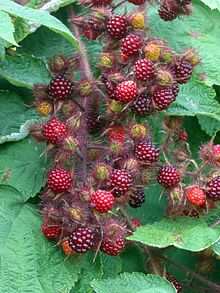Rubus phoenicolasius
| Rubus phoenicolasius | |
|---|---|

| |
| Scientific classification | |
| Kingdom: | |
| (unranked): | |
| (unranked): | |
| Order: | |
| Family: | |
| Genus: | |
| Subgenus: | |
| Species: | R. phoenicolasius
|
| Binomial name | |
| Rubus phoenicolasius | |
Rubus phoenicolasius (Japanese Wineberry, Wineberry, or Wine Raspberry) is a species of raspberry (Rubus subgenus Idaeobatus) native to northern China, Japan, and Korea.[2] The species was introduced to Europe and North America as an ornamental plant and for its potential in breeding hybrid raspberries. It has subsequently escaped from cultivation and become naturalised and sometimes invasive in parts of Europe and eastern North America.[3][4][5]
Characteristics
The species is a perennial plant which bears biennial stems ("canes") from the perennial root system. In its first year, a new stem grows vigorously to its full height of 1-3 m, unbranched, and bearing large pinnate leaves with three or five leaflets; normally it does not produce any flowers. In its second year, the stem does not grow taller, but produces several side shoots, which bear smaller leaves always with three leaflets; the leaves are white underneath.
The flowers are produced in late spring on short, very bristly racemes on the tips of these side shoots, each flower 6–10 mm diameter with five purplish red to pink petals and a bristly calyx. The fruit is orange or red, about 1 cm diameter, edible, produced in summer or early autumn; in botanical terminology, it is not a berry at all, but an aggregate fruit of numerous drupelets around a central core. Ripening occurs from early summer. The canes have fine, red thorns, which appear much like red hair.[2][3]
In addition to seed propagation, new plants are formed from the tips of existing canes touching the ground. They enjoy moist soil and grow near and within wooded areas.
As a fruit develops, it is surrounded by a protective calyx covered in hairs that exude tiny drops of sticky fluid. A 2009 study by Sina Pohl at the University of Vienna showed that plants do not get nutrients from insects caught in the sap: the sticky mucilage contains no digestive enzymes; surrounding tissues cannot absorb nutrients; and there are no protein-storage tissues. Also, unlike carnivorous plants, wineberry grows in nutrient-rich soil, so it has no need for insect nutrients.[6]
Cultivation and uses
This section needs expansion. You can help by adding to it. (November 2011) |
Wineberries grow wild throughout much of North America. They are common along the edges of fields and roadsides, but are not widely cultivated. They are one of the most easily identified wild edible plants, with no poisonous look-a-likes in North America. Other plants that wineberries may be mistaken for include the red raspberry, black raspberry, and blackberry, all of which are also edible. People who are just starting to learn how to gather wild food often start by gathering wineberries (and similar bramble fruit). Ripe berries are sweet and tart, with a raspberry-like flavor.
Wineberries are used in food much like raspberries, typically for pie or other sweet treats.
References
- ^ Rubus phoenicolasius was first described and published in Bulletin de l'Academie Imperiale des Sciences de St-Petersbourg 17(2): 160–161. 1872 "Name - Rubus phoenicolasius Maxim". Tropicos. Saint Louis, Missouri: Missouri Botanical Garden. Retrieved July 27, 2011.
- ^ a b Flora of China: Rubus phoenicolasius
- ^ a b Flora of NW Europe: Rubus phoenicolasius
- ^ Plant Conservation Alliance: Wineberry
- ^ Swearingen, J., Reshetiloff, K., Slattery, B., & Zwicker, S. (2002). "Wineberry". Plant Invaders of Mid-Atlantic Natural Areas. National Park Service and U.S. Fish & Wildlife Service.
{{cite web}}: CS1 maint: multiple names: authors list (link) - ^ Patterson Clark (June 29, 2010). "Wineberry's glandular hairs". Washington Post.
